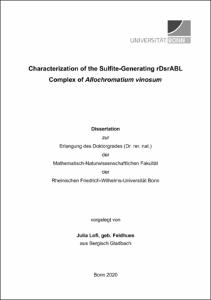Lofi, Julia: Characterization of the Sulfite-Generating rDsrABL Complex of Allochromatium vinosum. - Bonn, 2020. - Dissertation, Rheinische Friedrich-Wilhelms-Universität Bonn.
Online-Ausgabe in bonndoc: https://nbn-resolving.org/urn:nbn:de:hbz:5-60298
Online-Ausgabe in bonndoc: https://nbn-resolving.org/urn:nbn:de:hbz:5-60298
@phdthesis{handle:20.500.11811/8851,
urn: https://nbn-resolving.org/urn:nbn:de:hbz:5-60298,
author = {{Julia Lofi}},
title = {Characterization of the Sulfite-Generating rDsrABL Complex of Allochromatium vinosum},
school = {Rheinische Friedrich-Wilhelms-Universität Bonn},
year = 2020,
month = dec,
note = {Microbial pathways of sulfur dissimilation have strongly contributed to the evolution of the biogeochemical sulfur cycle and still play a major role in it today. Dissimilatory sulfite reductases, which occur in both sulfate reducing and sulfur oxidizing organisms, belong to the key enzymes of this nutrient cycle. The characterization of the reverse-acting dissimilatory sulfite reductase rDsrAB from the sulfur oxidizing model organism Allochromatium vinosum has an impact on our understanding of the (r)Dsr pathway in both sulfur oxidizers and sulfate reducers.
The sulfite reductase rDsrAB was shown to interact both structurally and functionally with the iron-sulfur flavoprotein DsrL in an rDsrABL complex. Due to its function as NAD(P)H:oxidoreductase and its interaction with rDsrAB, DsrL enables the electron transfer from NAD(P)H via rDsrABL onto sulfite. Accordingly DsrL seems to be the so far unknown physiological electron donor for sulfite reduction in those reducers, which encode for DsrL. In sulfur oxidizers DsrL presumably functions as NAD+ reductase, transferring electrons stemming from sulfite formation catalyzed by rDsrAB onto NAD+. As DsrL shows great homologies to NfnB, the bifurcating subunit of the NfnAB complex, it could potentially enable an electron bifurcation in which for instance ferredoxin is reduced driven by sulfite reduction and an electron confurcation in which protein-bound sulfur is oxidized driven by ferredoxin oxidation. The electron transfer between ferredoxin and DsrL was demonstrated in this study, an electron bifurcation could however not be proven so far.
Furthermore the functional interaction of rDsrABL with the small protein DsrC was demonstrated. DsrC with its two highly conserved cysteines CysA and CysB was shown to increase sulfite reduction rate of rDsrABL and to be consumed in the reaction in a CysA-dependent manner just like observed for DsrAB and DsrC from the sulfate reducer Archaeoglobus fulgidus. However the product of sulfite reduction in the presence of DsrC was a DsrC CysA persulfide and not a DsrC trisulfide as observed for the sulfate reducer. This indicates that a DsrC persulfide is also the substrate for sulfur oxidation catalyzed by rDsrABL, by which sulfite is generated.},
url = {https://hdl.handle.net/20.500.11811/8851}
}
urn: https://nbn-resolving.org/urn:nbn:de:hbz:5-60298,
author = {{Julia Lofi}},
title = {Characterization of the Sulfite-Generating rDsrABL Complex of Allochromatium vinosum},
school = {Rheinische Friedrich-Wilhelms-Universität Bonn},
year = 2020,
month = dec,
note = {Microbial pathways of sulfur dissimilation have strongly contributed to the evolution of the biogeochemical sulfur cycle and still play a major role in it today. Dissimilatory sulfite reductases, which occur in both sulfate reducing and sulfur oxidizing organisms, belong to the key enzymes of this nutrient cycle. The characterization of the reverse-acting dissimilatory sulfite reductase rDsrAB from the sulfur oxidizing model organism Allochromatium vinosum has an impact on our understanding of the (r)Dsr pathway in both sulfur oxidizers and sulfate reducers.
The sulfite reductase rDsrAB was shown to interact both structurally and functionally with the iron-sulfur flavoprotein DsrL in an rDsrABL complex. Due to its function as NAD(P)H:oxidoreductase and its interaction with rDsrAB, DsrL enables the electron transfer from NAD(P)H via rDsrABL onto sulfite. Accordingly DsrL seems to be the so far unknown physiological electron donor for sulfite reduction in those reducers, which encode for DsrL. In sulfur oxidizers DsrL presumably functions as NAD+ reductase, transferring electrons stemming from sulfite formation catalyzed by rDsrAB onto NAD+. As DsrL shows great homologies to NfnB, the bifurcating subunit of the NfnAB complex, it could potentially enable an electron bifurcation in which for instance ferredoxin is reduced driven by sulfite reduction and an electron confurcation in which protein-bound sulfur is oxidized driven by ferredoxin oxidation. The electron transfer between ferredoxin and DsrL was demonstrated in this study, an electron bifurcation could however not be proven so far.
Furthermore the functional interaction of rDsrABL with the small protein DsrC was demonstrated. DsrC with its two highly conserved cysteines CysA and CysB was shown to increase sulfite reduction rate of rDsrABL and to be consumed in the reaction in a CysA-dependent manner just like observed for DsrAB and DsrC from the sulfate reducer Archaeoglobus fulgidus. However the product of sulfite reduction in the presence of DsrC was a DsrC CysA persulfide and not a DsrC trisulfide as observed for the sulfate reducer. This indicates that a DsrC persulfide is also the substrate for sulfur oxidation catalyzed by rDsrABL, by which sulfite is generated.},
url = {https://hdl.handle.net/20.500.11811/8851}
}






